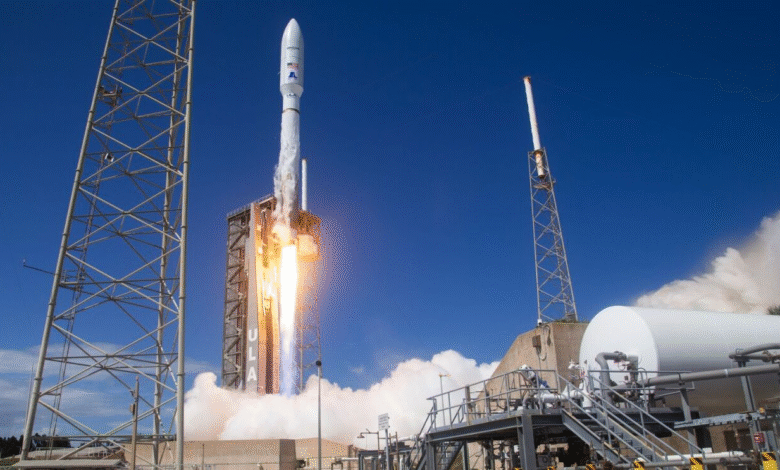Project Kuiper Launch Delay: New Date Set for Satellites

The recent announcement regarding the Project Kuiper launch delay has sparked interest among tech enthusiasts and industry professionals alike. Originally slated for Friday, the launch of Amazon’s satellite network, designed to deliver high-speed internet globally, has been pushed back to June 16 due to multiple weather-related setbacks. This second batch of satellites is crucial for bolstering Amazon’s Kuiper internet service, which aims to rival existing market players like Elon Musk’s Starlink. As news breaks regarding ULA’s launch plans, the stakes heighten in the satellite competition arena, with Amazon aiming for an expansive fleet to serve underserved regions. With 27 new satellites joining the initial batch of 27, Amazon is working diligently to meet ambitious deployment goals set by the Federal Communications Commission (FCC).
The delay in launching Amazon’s satellite initiative, known as Project Kuiper, is making waves across the tech industry and beyond. This ambitious project, designed to provide fast, reliable internet through a network of low Earth orbit satellites, faces challenges from unpredictable weather conditions. With the revised launch date set for June 16, the stakes are raised as Amazon positions itself against formidable rivals in the satellite internet sector. Following the successful deployment of their first group of satellites, the upcoming mission is pivotal for expanding their orbital fleet and enhancing service offerings. As Amazon gears up for this significant milestone, the updates from ULA continue to capture attention amidst the growing satellite competition.
Project Kuiper Launch Delays: Understanding the Impact
United Launch Alliance (ULA) has announced a delay in the launch of Project Kuiper, Amazon’s ambitious satellite internet initiative, due to adverse weather conditions. Originally set for a Friday launch, the new date is now scheduled for June 16. This postponement reflects the unpredictability often faced in space missions, where environmental factors can significantly affect launch windows. As ULA cited ‘multiple weather delays,’ it emphasizes the critical importance of favorable launch conditions for the success of satellite deployments.
These delays not only impact the timing but also the competitive landscape of satellite internet services. As Amazon races to deploy its Kuiper constellation, the delay may afford competitors like Elon Musk’s Starlink an opportunity to solidify their market positions. With multiple weather-related setbacks, the pressure is on for Amazon to adhere to its ambitious schedule to launch a total of over 3,000 satellites in the upcoming years.
The Strategic Importance of Amazon’s Kuiper Internet Service
The Project Kuiper internet service is designed to provide high-speed, low-latency internet access to underserved areas around the globe. As Amazon strives to establish a comprehensive satellite constellation, its endeavors align with global efforts to enhance connectivity. By sending 27 additional satellites into orbit during the upcoming launch, Amazon will expand its operational capacity and get closer to meeting its goal of offering broadband services worldwide.
This competitive push is underscored by the regulatory requirement from the Federal Communications Commission (FCC), mandating that Amazon must deploy at least half of its satellite constellation by July 2026. With a robust strategy in place, Amazon’s Kuiper has the potential to disrupt the current satellite internet market dominated by rivals like Starlink, making the timely deployment of these satellites critical.
The Role of ULA in Launching Amazon’s Satellite Constellation
United Launch Alliance plays a pivotal role in Amazon’s satellite deployment strategy, particularly with its Atlas V rocket, which is specifically designed for delivering payloads into orbit. As the partnership evolves, each launch contributes significantly to the realization of Amazon’s satellite network ambitions. The reliability of ULA is crucial, as evidenced by the current launch delays, which highlight the extensive planning and technical precision required in rocket launches.
Returning to the launch scheduled for June 16, the Atlas V will transport additional Kuiper satellites, enhancing the overall fleet size and capabilities of Amazon’s internet service. By coordinating efforts with ULA, Amazon is better positioned to not only meet its initial satellite deployment goals but also effectively compete against other satellite providers in an increasingly crowded field.
Competing Forces: Project Kuiper vs. Starlink
The competition between Project Kuiper and SpaceX’s Starlink is rapidly intensifying as both companies seek to claim dominance in the satellite internet market. With Amazon’s announcement of a second batch of 27 satellites set to launch in the coming weeks, the comparisons to Starlink’s extensive satellite network capabilities become inevitable. As both companies innovate and expand their operational fleets, the advancements in technology and customer service offered by each could reshape the landscape of global internet accessibility.
Starlink has made significant strides in early deployments, while Amazon faces the dual challenge of meeting regulatory deadlines while ensuring reliable service. The battle for a substantial share of the satellite internet market underscores the importance of timely launches and efficient satellite deployment strategies, making the success of the Project Kuiper launch critical for Amazon’s competitive posture.
Weather-Related Challenges in Satellite Launches
Weather conditions play a critical role in satellite launches and can cause significant delays, as observed in the recent postponement of Amazon’s Project Kuiper launch by United Launch Alliance. Factors such as high winds and rain at Cape Canaveral necessitate strict safety measures, preventing launches during adverse weather. This aspect is often an overlooked element in the space industry, yet it directly impacts the preparations and scheduling of satellite deployments.
To mitigate these challenges, launch providers like ULA rely on comprehensive weather forecasting and monitoring systems. Each delay not only impacts operational timelines but also strategic business planning for satellite companies striving to establish their services and meet customer demands. For Amazon, navigating these weather-related challenges is part of a larger strategy to ensure that its Kuiper service can launch successfully and reach customers as planned.
Kuiper Constellation Size: Aiming for Global Coverage
Amazon’s ambition to launch a network of over 3,000 satellites highlights its commitment to providing widespread internet coverage. By launching batches of Kuiper satellites incrementally, the company aims to build a robust constellation that can effectively serve various geographic regions, particularly in rural and underserved areas. By adding another 27 satellites, Amazon edge closer to solidifying its presence in the global connectivity landscape.
As the number of satellites increases, so does the potential for enhanced service quality and reliability. Amazon’s race to accumulate a total of 1,618 satellites by the FCC’s deadline of July 2026 only intensifies its strategic efforts. Each successful launch is a step toward achieving a constellation that can compete not only in quantity but also in the quality of service offered.”}]},{
Strategic Goals of Amazon’s Project Kuiper Development and Deployment Phase
Amazon is not just aiming for numbers with Project Kuiper; it’s also focused on the strategic deployment of technology that will deliver fast and reliable internet access. The ambition behind Kuiper is not solely about launching thousands of satellites; it’s about creating a network capable of competing in market share and technological efficiency against established players like Starlink. The upcoming launch represents a crucial step towards achieving these goals, as Amazon works to ensure that this new constellation of satellites functions seamlessly and expands coverage.
Additionally, the company has a keen eye on their operational strategy concerning data transfer speeds and latency. Through the meticulous arrangement of satellites in low Earth orbit, Amazon intends to optimize their internet service performance. The eventual goal is to provide a level of service parity — if not superiority — to existing competitors within the same timeframe. This commitment to processing technology and customer satisfaction ensures that they are not just reactive, but proactive in their development priorities.
Regulatory Milestones During Kuiper’s Launch Timeline
Navigating the regulatory landscape is critical for Amazon as it seeks to expand its satellite internet service through Project Kuiper. The Federal Communications Commission (FCC) plays a pivotal role in overseeing U.S. satellite operations, setting strict timelines and operational benchmarks that companies must meet. Fulfilling these benchmarks not only establishes credibility but also strengthens business partnerships with satellite service consumers.
The requirement that Amazon must deploy half of its planned 3,236 satellites by July 2026 is a guiding framework for the company’s operational timelines. Each successful launch offers not just an increase in their satellite count, but also contributes to adhering to the regulatory milestones set forth by the FCC. This structure means every operational decision made by Amazon regarding its Kuiper service directly impacts its long-term strategy and regulatory compliance.
Future Outlook for Satellite Internet Competition
The future of satellite internet appears promising yet competitive, with Project Kuiper and Starlink poised to challenge traditional internet service models. As companies aim to provide widespread internet coverage through low Earth orbit satellites, the battle for market supremacy intensifies. Having already launched several batches of their respective satellites, both Amazon and SpaceX are racing to capture the attention—and subscriptions—of consumers eager for faster connectivity.
Looking forward, predicting the winner in this evolving market will depend on various factors, including reliability, cost, technology deployment speed, and service quality. Consumer trends will largely dictate which service eclipses the others, reinforcing the importance of strategic launches like Amazon’s Project Kuiper. Companies that can innovate and adapt rapidly will likely thrive in the satellite internet ecosystem.
Frequently Asked Questions
What caused the Project Kuiper launch delay?
The Project Kuiper launch delay was caused by multiple weather delays during launch processing, as stated by United Launch Alliance (ULA). Originally scheduled for Friday, the launch of Amazon’s satellites has been rescheduled for June 16 due to adverse weather conditions experienced in Florida.
When is the new launch date for Amazon’s Project Kuiper satellites?
The new launch date for Amazon’s Project Kuiper satellites is now set for June 16 at 1:25 p.m. ET. This launch will carry another batch of 27 satellites to increase the total constellation to 54 satellites in orbit.
How will the Project Kuiper satellites compete with other internet services?
Amazon’s Project Kuiper satellites are designed to compete with existing internet services like Elon Musk’s Starlink. With a vision to deploy over 3,000 satellites, Project Kuiper aims to offer reliable internet service and expedite satellite deployments to capture market share in the satellite internet service sector.
What is the status of the Project Kuiper satellite constellation?
As of now, Amazon has successfully launched 27 Project Kuiper satellites in April, and with the upcoming launch on June 16, the constellation will expand to 54 satellites. Amazon is working to meet regulatory requirements to have at least 1,618 satellites operational by July 2026.
What impact will the Project Kuiper launch delay have on its market entry?
The Project Kuiper launch delay may have an impact on Amazon’s timeline for entering the satellite internet market. The company is aiming to provide commercial service to customers later this year, and any delays could affect their ability to meet this goal amidst increasing competition from other satellite services.
What is the significance of the ULA in the Project Kuiper launches?
United Launch Alliance (ULA) plays a crucial role in the Project Kuiper launches, providing the Atlas V rocket to transport Amazon’s satellites into orbit. ULA’s expertise is vital in executing the launches safely and effectively, despite the recent delays due to weather conditions.
What are the future prospects for Project Kuiper after the launch delays?
Despite the recent launch delays, Project Kuiper has ambitious plans to expand its satellite constellation significantly. Amazon aims to establish a robust internet service through its satellites, competing with rivals like SpaceX’s Starlink, and is committed to adhering to FCC mandates for satellite deployment.
| Key Point | Details |
|---|---|
| Launch Delay | The launch of Amazon’s Project Kuiper satellites is delayed until June 16 due to weather issues. |
| Rocket and Launch Site | An Atlas V rocket is prepared for the launch at Cape Canaveral Space Force Station. |
| Weather Issues | Multiple weather delays, including rain and high winds, prompted the launch postponement. |
| Total Satellites Sent | The upcoming launch will send 27 additional satellites, increasing the total to 54. |
| Competition | Project Kuiper will compete with SpaceX’s Starlink for the satellite internet market. |
| Regulatory Requirements | Amazon needs to launch half of its 3,000 satellite constellation by July 2026 to comply with FCC regulations. |
Summary
The Project Kuiper launch delay has highlighted the challenges faced by Amazon in deploying its satellite network. Originally scheduled for Friday, the launch has been postponed to June 16 due to adverse weather conditions, which have impacted launch readiness at Cape Canaveral. With this upcoming launch, Amazon aims to send 27 more satellites into orbit, intensifying its competitive landscape against established players like Elon Musk’s Starlink. As the pressure mounts to meet regulatory deadlines while expanding its global internet service, the successful execution of the Project Kuiper launch will be crucial for Amazon’s ambitious technological goals.




